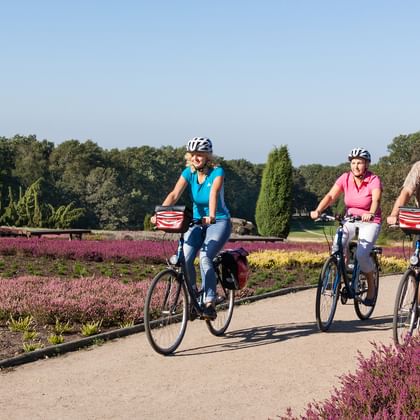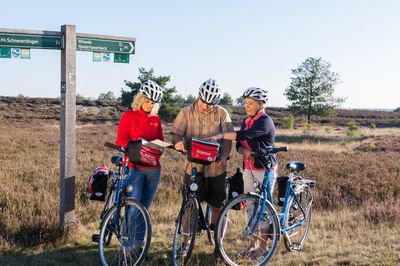Heath landscape and nature protection
A prejudice persists that heathland is only beautiful when the heather plants bloom purple. Postcard kitsch a la heath poet Hermann Löns. Only the smallest facet of one of the oldest, largest and most beautiful nature reserves in Germany.
Discover on the bike tour "Lüneburger Heath" a landscape and its secrets, which really inspires in every season.
The nature of the heath, its regional cuisine, legends and stories cannot be found anywhere else. The alternation of heath landscape, forest and field make the flair of this bike tour.

A mixed oak forest covered the land in primeval times, a light deciduous forest. Not a heath landscape as we know it today. Farming and animal husbandry, together with hunting and gathering, formed the basis of life for the people here. To make room for settlements, the forest had to be cleared with stone axes or burned down.
As early as 3,000 BC. man began to roam the forests with his sheep. The latter were only too happy to bite at the lush green of the emerging young oaks. Intensive grazing encouraged the steady thinning of forests, and more open areas increased. Grazing-resistant plant species settled, the broom heath. In addition, there were birch and juniper. At times, for example in the 18th century. In the 19th century, the heath landscapes thus created extended over large areas. Today, contiguous areas exist almost only in the Lüneburg Heath Nature Park. Unreal cultural landscape!

Reetgedecktes Haus Lüneburger Heide
Here you can also see the great contradiction of the nature park. The landscape was shaped by man, not only by the forces of nature. There is no such thing as a “real” heath landscape, man changed the landscape through his use.
If the heaths were not constantly being fightsed, light deciduous forests and bogs would be created. Today’s characteristic, this world of purple color, would quickly disappear.
The Luneburg Heath needs the right amount of agriculture and care in order to be preserved

Hanseatic city Lüneburg
The small, tranquil old town is already more than 1,000 years old. The city of Lüneburg achieved great prosperity through the salt dome. The salt still appears today in the form of a 36 per cent salt water source (sun). The salt extracted in the saltworks was worth gold. In the past, it was absolutely necessary to salve fish and meat. Salt Museum Lüneburg.
Lüneburg became one of the richest cities in the country and a member of the Hanseatic
North German brick Gothic, magnificent medieval patrician houses with artfully decorated gables and imposing townhouses dominate the architecture of the city.
The city of Lüneburg glows red, the wealth is visible everywhere in the beautiful historic cityscape. In particular, the churches of St. John, St. Michaelis, Ev. -luth. Kirchenkreis and many more are classics of true North German brick Gothic.
Further tips: Monastery of Lüne, Shiplifts-Scharnebeck, Old Crane in the Port of Lüneburg.

(and the sweet riches: sugar)
In Uelzen stands one of the oldest and largest sugar factories in Europe, built in 1883. For centuries, cane sugar and honey were the only and correspondingly precious sweeteners. The discovery by Andreas Sigismund Markgraf in 1747 that beets also contain sugar was therefore of great importance. But that's not all Uelzen has to offer! The city's sights and landmarks imprint tourists with fond memories, such as the Hundertwasser train station. The station is a piece of living art. The things of everyday life are wonderfully integrated into the station.
An eye-catcher for everyone!
A special art attraction is “The Way of Stones. ” This stone path adorns Uelzen’s streets from the train station to the city center. The German-Swedish artist Dagmar Glemme has created a picturesque cosmos on the 21 rocks. Look forward to the 50 – 100 meter high stones with wonderful signs and symbols, mythical creatures and a lot of artistic style.
Celle
Celle is one of the highlights on your bike tour through the Lüneburg Heath.
The reasons speak for themselves: the mixture of compact and large half-timbered houses, the modern architecture, many classical to modern museums as well as the Guelph Castle with its castle theatre. This city shows culture in its own way.
Popular sights in Celle:
- Celle Castle
- Museum in the castle Celle
- Bomann Museum
- Church St. Marien
- Castle theatre (Schlosstheater)
The weekly market in Celle has a 700 year old tradition. It is a great experience against the backdrop of the romantic old town and castle. The fresh goods from the region show that the Lüneburg Heath has more to offer than Heath potatoes. The market always takes place on Wednesdays and Saturdays.
You will get to know the varied cafés and restaurants just by strolling through the city centre. A beautiful city with many breathtaking memories.
Soltau
Soltau is a town in the middle of the Lüneburg Heath with about 21,600 inhabitants.
Soltau was first mentioned in a document in 936. The bailiwick of Soltau was sold to the cathedral capital of Verden in 1304. On 15. 07. In 1388 Soltau received the town charter.
Whether relaxation, action or shopping. The city of Soltau offers not only the great landscapes and beautiful buildings!
In 1978, northern Germany's largest amusement park, the Heide Park Resort, was opened. In 1984 the play museum was opened. Another tourist attraction came with the Soltau-Therme in 1990.
You will find over 80 designer brands at 30-70% off in the shopping centre "Designer-Outlet" Soltau.
Hermannsburg
The small town of Hermannsburg is located in the Nature Park of the Südheide. It comprises a ca. 500km2 large area and covers 1/3 of the area of the district with countryside. The landscape consists of 65% forest, moorland, heathland, horse paddocks and heath streams.
Here, relaxation is the order of the day!
Schneverdingen
The state-approved climatic health resort of Schneverdingen rounds off the bike trip with a beautiful play of colours in the Lüneburger Heide. You will discover the idyll of beautiful heaths, endless forests and mysterious moors with all your senses.
The heath garden with its more than 200 different heath species in Schneverdingen should be visited. A sight-seeing facility on an old sheepfold, which glows in the most beautiful shades of purple when the heath blooms. Completed in 1990, the heath garden has grown steadily. It is a freely accessible area on the outskirts of the village, which you can visit free of charge around the clock, well signposted in Schneverdingen.
Our insider tip: In the sheepfold near the L 171 and the Heide kiosk, the Heidschnucken of Schneverdingen’s shepherd Günther Beuße are at home. From Easter to October, visit the out- and in-storage of the herd always around 10:30 a. m. and 5:00 p. m.
You can also look forward to culinary delights. In the Lüneburger Heide there are many regional dishes, which are prepared with great love (as a souvenir).



